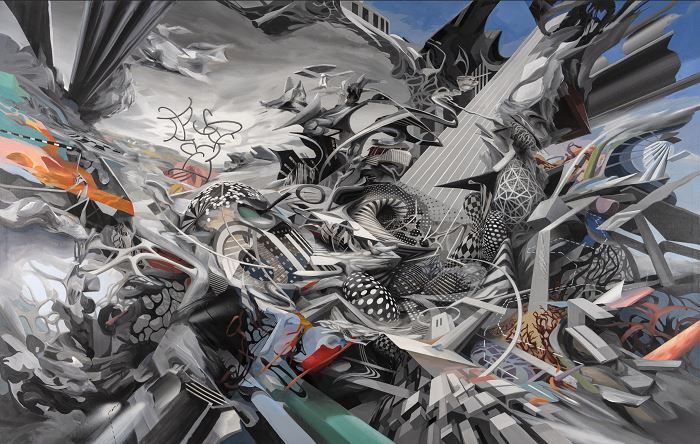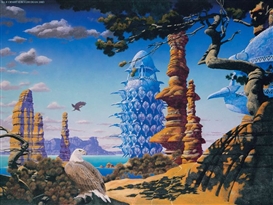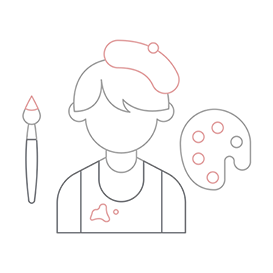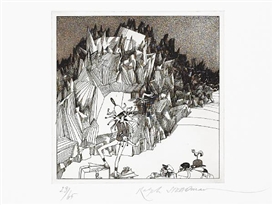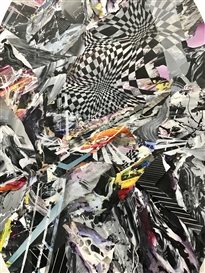Emerging Markets: Brian Chambers and the New Psychedelia
The curator and art dealer recognized the potential of psychedelic art 30 years ago, and in November opens a new gallery dedicated to it
Michael Pearce / 黑料不打烊
Oct 29, 2021
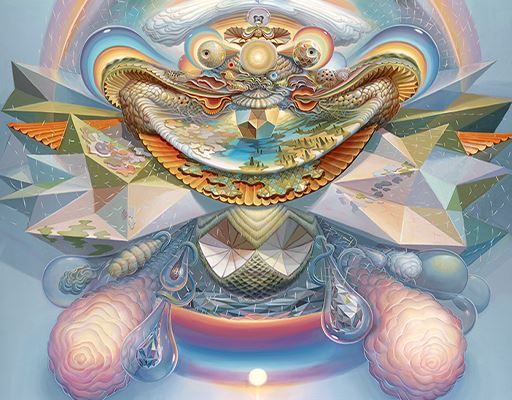
The curator and art dealer recognized the potential of psychedelic art 30 years ago, and in November opens a new gallery dedicated to it.
Brian Chambers' magic bus, painted by Colin Prahl. (Photo courtesy of Bailey Whitehill). Photo provided by The Chambers Project
Parked on a dry and silent California hilltop lot at the high end of a winding road finishing as a dirt track under the shade of the pine-perfumed forests laying in the foothills of the Sierras which rise rolling from the plains North-North-East of Sacramento, there is a school-bus facing the sunrise which has been converted into a comfortable camper, and has been decorated with the mind-expanding patterns of LSD, DMT and psilocybin — but this is neither a derivative copy of the lazy and amateur boomer mess of scrawled and flowery psychedelia that plastered Further, the legendary magic bus of Ken Kesey and the Merry Pranksters of the Electric Kool-Aid Acid Test, or their 60s imitators, nor a nostalgic return to the crude gypsy days of the hippy era, for this spectacular mural on wheels has been carefully designed by an inspired master of observation who has the disciplined mind and precise hand necessary to capture the aesthetic complexities of the elusive visuals of the entheogenic state in the cyber-punk present: an artist named Colin Prahl, one of the new wave of master painters who have transformed the psychedelic genre. The bus belongs to Brian Chambers.
Tall, bearded, athletic, and full of enthusiastic energy, Chambers is the curator and eponymous head of the Chambers Project, and has worked at the heart of new psychedelia for the past three decades. His career as an art dealer began in 1995 when he discovered the mind-bending artwork of Ralph Steadman and Rick Griffin, and immediately recognized the potential for a developing market in psychedelic art, and began following his path as curator and collector. Steadman needs little introduction, for he is among the pantheon of great satirical illustrators, particularly famous for his symbiotic relationship with gonzo journalist Hunter Thompson. Thompson opened his famous novel Fear and Loathing in Las Vegas with a deranged description of bats swooping, and screeching, and diving around his convertible. Steadman made a notorious illustration of the moment for the book titled A Savage Journey to the Heart of the American Dream, which Chambers now sells as large, signed, limited-edition prints. Griffin is less well known outside a cult-following for his iconic album cover work for the Grateful Dead, and the California surfing subculture, but he was a brilliant and hallucinatory cartoonist, and Chambers cares for a small collection of his work.
Oliver Vernon, Embryo. Photo provided by The Chambers Project
But this isn’t about mementos and memorabilia to stimulate the nostalgic memories of aging bourgeois ex-bohemians, for although its history is important to Chambers, psychedelic art has evolved dramatically since its early days in the darkened and illicit underground of 20th century drug culture, and he is more interested in what is happening in the present. The compounds which inspire the audience for it are more socially accepted now than they have ever been. Many countries no longer enforce laws controlling possession of marijuana, which has been legalized in many American states, with more likely to follow in relaxing their laws governing its use. In Oregon, small-scale drug possession has been decriminalized. The American cities of Denver, Oakland, Santa Cruz, Washington D.C., Cambridge (Mass.) and Somerville have all decriminalized psilocybin. In California, psychedelic therapy has been legalized, and is considered especially effective as treatment for post-traumatic stress disorder, and as a transformative tool for ending heroin and alcohol addiction. Micro-dosing — the practice of taking small daily doses of psilocybin or LSD - has become de rigeur among Silicon Valley’s smart set, who believe it enhances creativity and perception. War on drugs? Drugs won. Now they’re a tool for enhancing performance. Psychedelic art hasn’t changed in order to infiltrate the boundaries of what is considered acceptable to society — the boundaries of what is considered acceptable to society have changed to include psychedelic art, and this movement has stimulated increasing confidence and sophistication in the work.
The artists Chambers nurtures produce superb, beautiful art which transcends psychedelia’s murky past. Their paintings are clean, abstract and luxurious, and invite contemplation and meditation, and the best of them are making an early impact in the elusive and untapped Silicon Valley art market. Tech-heads are not known for their art collections, but Chambers’ sparkling brand of highly evolved psychedelia is finding a market there — in March he sold four paintings by Alex Grey for a million dollars to an influential San Francisco coder. Grey is the master of brilliantly controlled paintings of contemporary mind-expansion, believing in LSD as a sacred sacrament — his fellow travelers in the rock band Tool used his art as covers for their classic albums Lateralus, released in 2001, and the 2006 10,000 Days. Grey’s extraordinary work rewards close scrutiny, for there are inspired and twisting journeys to take among the dazzled and turning patterns, and he has a unique style which imagines a psychedelic kundalini flowing through and around human figures like bright medical illustrations. He has a devoted following, and runs a “Chapel of Sacred Mirrors” in New York which shares twenty-one large pieces of his sacred art in a space designed for spiritual transformation.
Jerry Garcia 1966. Photo provided by The Chambers Project
To show off this new psychedelic art Chambers has opened an impressive new gallery in Grass Valley, California, including 2000 sq ft of exhibit space, and a 4000 sq ft bronze foundry and metal fabrication space. Appropriately, the opening reception for the inaugural group show at The Chambers Project, titled “One Step Further” is set for November 12, 2021, the fiftieth anniversary of Fear and Loathing in Las Vegas, which began his journey in these anarchic frontiers of the art world. Extremely rare paintings by Jimi Hendrix and Jerry Garcia establish the historical context of the relationship between psychedelic art and music. Ralph Steadman’s original Dr. Gonzo and Roger Dean’s new painting The Quest drive home the connection between the past and present — Dean’s first cover art for the band Yes, Fragile, was also released fifty years ago, on November 26, 1971. His daughter Freyja Dean has inherited her father’s skill, and is quickly developing a reputation as a serious visionary artist. Based in Japan, this will be the first showing of a painting by her in the USA. Among the long list of participants, new abstract studio paintings by Oliver Vernon, Sebastian Wahl, Justin Lovato and Colin Prahl, and street influenced works by Mear One, Isaac Abrams, and by Zoltron represent the kaleidoscope of the exciting new direction Chambers is shaping for the visionary future of psychedelic art.
Mars-1 and Alex Grey, Bicycle Day. Photo provided by The Chambers Project
Some of the paintings of this new psychedelia are made collaboratively. Early in his career as an art dealer, Chambers recognized that eclectic collaborations were a characteristic of the psychedelic community, and created opportunities for his artists to make performance paintings before audiences at festivals and bohemian events, and sometimes these were made privately — he has commissioned collaborative works by Mars-1 (Mario Martinez) and Grey; by Mars-1 and Steadman. At the opening, Mars-1 and Vernon will make a new collaborative painting, accompanied by the music of A Path Untold, and other top-drawer music acts. “I’m redefining what an art opening can and should be,” says Chambers.
In the new gallery, gorgeous, gentle paintings by the lyrical Mars-1 stand out for their unusually subtle intricacy, and precise ethereal beauty — they are paradoxically fluid and sensual, but carefully structured and painstakingly detailed, and his appealing palette is soft and delicate and seductive, and the large scale of the paintings invites all-over immersion like the painterly abstract expressionists, but often turning abstract geometrical forms into three-dimensional shapes — and he is not alone in his adaptation of the formalism of abstract art, for Oliver Vernon achieves a similar balance of cascading shapes, which completely fill the space, but his work is faster, and spikier, and the landscape is less calming. There is a here, here. These are pictures of the unknown places of the mind. Paintings by Mars-1 and Vernon sell for well into six figures.
Mars1, Nuclear Mystics. Photo provided by The Chambers Project
To lie on the cool bed in the painted bus bathed in the golden light of California’s dusty sunset is to be enfolded within a huge painting, and dreaming within the tumbling abstract world of evolved psychedelia, and this beautiful new species of art is a doorway to deep experience, fulfilling the goal of all great art: to create a connection between one and another, to go further, and to enter the endless possibilities of the mind in a transformed aesthetic era, where the old stigmas of exploring inner worlds are erased. Chambers saw the future of art in 1995, and it was psychedelic.
For more on auctions, exhibitions, and current trends, visit our Magazine Page







.Jpeg)
